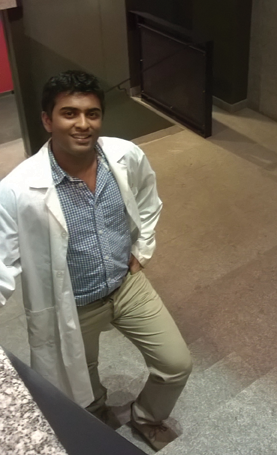You can spot Sanahan Vijayakumar on campus by his stylish French apparel, ear-to-ear grin, and fast paced chatter. The U2 materials engineer is an active member of the Engineering Undergraduate Society Council, and is known for his friendly attitude, passion, and outstanding success. Vijayakumar has been conducting research at McGill since he entered his program. In total, he has worked on three research projects in three different laboratories across the world, and has even been published in the Advanced Functional Materials Journal. Currently, he’s on the verge of doing it all again.
It has been two years since Vijayakumar began working in the McGill Bio-Interference Lab, supervised by Professor Marta Cerruti. The research focuses on placing special biodegradable scaffolds in dental tissue in order to stimulate and induce the production of hydroxycarbonate apatite (HCA).
“HCA is a calcite our bodies produce to initiate biomineralization,” Vijayakumar explained.
Biomineralization is the growth of inorganic material in a living host. Through biomineralization, cells within a tissue can take up the new minerals and use them to relieve deficiency, thereby healing any damage, injury, or infection that the tissue may be suffering from. Scaffolds, combined with certain drugs, including antibiotics, are emerging as a new way to treat infections and holes along the gum lining. Moreover, the insertion of the scaffolds will also activate HCA production, which serves to fill up the holes in the gum lining.
Vijayakumar is currently in charge of the production of the scaffolds and their structural analysis, using a scanning electron microscope to analyze whether the two building blocks—low and medium molecular weight chitosan—will bind. While his time at McGill has been important, these are just one of the many small steps that he’s taken in his research career.
According to Vijayakumar one of the most interesting aspects of doing research is the diversity of sciences contributing to a project and interacting with co-workers from a multitude of scientific backgrounds. These collaborations have helped him along the way, too.
He was able to find another research position in California in the summer of 2013, in a completely different area of research, due to his experience working with chitosan, a polysaccharide that the dental scaffolds in Cerruti’s research are made of. His new project, funded by the U.S. government, focuses on treating inflammations in the brain caused by post traumatic injuries. By coating drugs with chitosan, the complex can pass through the blood-brain barrier to treat the patients.
Not surprisingly, when a visiting professor met Vijayakumar in California during his research, he offered him a position in Tours, France for the summer of 2015 because he was impressed by Vijayakumar’s work. The professor is working with silicon wafers for high-efficiency anodes, which would later be used in creating more advanced batteries. Even though he found new research positions through interacting with colleagues and professors, Vijayakumar attributes his qualifications for the two new positions he was offered to what he learned during his research at McGill.








